Seven Questions Over Breakfast with Sonia Lynn Sadler
 April 7th, 2011 by jules
April 7th, 2011 by jules
(Click to enlarge.)
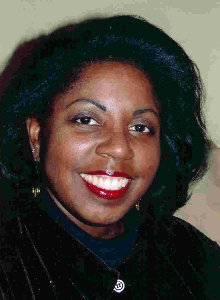 Won’t you join me in welcoming to 7-Imp this morning scratchboard illustrator Sonia Lynn Sadler? Sonia is the recipient of the 2011 Coretta Scott King/John Steptoe New Talent (Illustrator) Award for her illustrations in Jen Cullerton Johnson’s Seeds of Change, featured here at 7-Imp last August. Kirkus, in describing this book as “{v}ibrant and accomplished,” praised Sadler’s ability to so joyfully celebrate the community spirit that the book’s subject—2004 Nobel Peace Prize recipient Wangari Maathai, a Kenyan environmental and political activist—brought to those with whom she worked.
Won’t you join me in welcoming to 7-Imp this morning scratchboard illustrator Sonia Lynn Sadler? Sonia is the recipient of the 2011 Coretta Scott King/John Steptoe New Talent (Illustrator) Award for her illustrations in Jen Cullerton Johnson’s Seeds of Change, featured here at 7-Imp last August. Kirkus, in describing this book as “{v}ibrant and accomplished,” praised Sadler’s ability to so joyfully celebrate the community spirit that the book’s subject—2004 Nobel Peace Prize recipient Wangari Maathai, a Kenyan environmental and political activist—brought to those with whom she worked.
Sonia is visiting for breakfast this morning—“a home-made veggie omelet with gouda and a cup of hot tea with lemon” is her meal-of-choice—-to tell me what she’s working on now and to share some art from Seeds of Change, as well as her previous titles. I’m pleased to have her here, and I hope you enjoy all the bright art she’s sharing today. She opts for tea, not coffee, but I dare say I don’t need coffee to wake me up, what with her beautiful images here this morning. Let’s get right to it (mostly ’cause I really want to talk to her, but also ’cause SHE IS BRINGING GOUDA), and I thank her for stopping by.
Jules: Are you an illustrator or author/illustrator?
Sonia: Illustrator.
Jules: Can you list your books-to-date?
Sonia:
Jules: What is your usual medium, or––if you use a variety—your preferred one?
Sonia: My medium for illustration is scratchboard painting.
she shared the seeds of change.”
Three spreads from Jen Cullerton Johnson’s Seeds of Change (Lee & Low, 2010)
(Click to enlarge all spreads)
Jules: If you have illustrated for various age ranges (such as, both picture books and early reader books OR, say, picture books and chapter books), can you briefly discuss the differences, if any, in illustrating for one age group to another?
Sonia: The Goat Goes to Town is an early reader book; it has a simple story with more pictures than words. Ma Dear’s Green House and Seeds of Change are picture books, but the writing is more intense and descriptive. In Seeds of Change, written by Jen Cullerton, the writing is very detailed, which lead to my sketches being detailed.
(Just Us Books, 2004)
(Click to enlarge)
Jules: Where are your stompin’ grounds?
Sonia: I live in West New York, NJ, and have friends in Brooklyn and Bowie, Maryland. Usually, when something social is going on, it is not where I live. I guess I am used to traveling.
Jules: Can you briefly tell me about your road to publication?
Sonia: I was in an art show, and one of the children’s book editors saw my work and then assigned a book for me to illustrate. Also, one editor in one company called another and told them about me.
more than once. Even the dog hangs in.”
(Click to enlarge)
Jules: Can you please point readers to your web site and/or blog?
Sonia: www.SoniaLynnSadlerArts.com
Jules: If you do school visits, tell me what they’re like.
Sonia: I have only visited one school to date, but I will be doing others. The kids were very interested in the process of the medium that I use and how I use color. The one I visited had a really good art program, and the kids were regularly exposed to art.
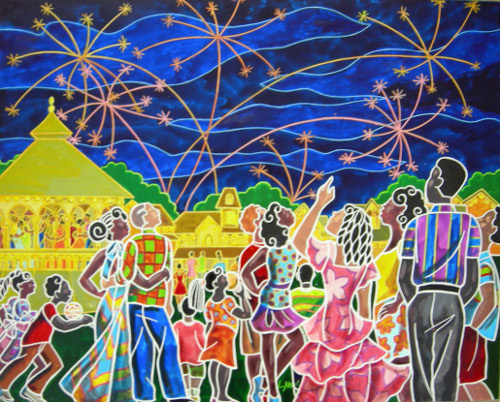
Jules: If you teach illustration, by chance, tell me how that influences your work as an illustrator.
Sonia: I do not teach illustration, but what have influenced me as an illustrator are artists such as Matisse, Romare Bearden, the art period of Art Nouveau, and vintage Japanese woodcuts.

Hidden in Plain View. The story goes that a quilt would be hung out as a
message for runaway slaves.”
Jules: Any new titles/projects you might be working on now that you can tell me about?
Sonia: I have decided to put some of my own works together into a picture book which tells a story. Also, I am currently writing a couple of my own children’s books.
 Our table’s set now for our breakfast interview, and our tea has steeped. Let’s get a bit more detailed, and I thank Sonia again for stopping by for six questions over breakfast.
Our table’s set now for our breakfast interview, and our tea has steeped. Let’s get a bit more detailed, and I thank Sonia again for stopping by for six questions over breakfast.
1. Jules: What exactly is your process when you are illustrating a book? You can start wherever you’d like when answering: getting initial ideas, starting to illustrate, or even what it’s like under deadline, etc. Do you outline a great deal of the book before you illustrate or just let your muse lead you on and see where you end up?
Sonia: First, I read a couple of times the script that was sent and visualize what has been written. Then I sketch the ideas … Just free thumbnail sketches.
I did quite a bit of research for Seeds of Change, which was about a living person (Wangari Maathai) as a child in Kenya. I looked up everything from hair, clothes, textile patterns, landscapes, cities, everything. I had not been to Kenya, so I wanted to get the best feel for the area and people that I could.
(Click to enlarge)
 There is a lot of back and forth with the editors, and they will have comments on book design or if a scene needs to be added or deleted, because there are so many pages to a book. Sometimes my ideas about the look are different from what the editors had in mind, and I need to illustrate further what I had in mind. There are a few deadlines, and the rough images must be scanned and reviewed a few times before I begin to paint. When I have all my layout approved, then I transfer all of the layouts to the scratchboard. I mix some colors beforehand to make them consistent throughout. Finally, after all that I paint all the layouts. The layouts are reviewed again before I put on the final touch, which is scratching out the lines. Sometimes I will go back and paint a color back in the line. I have to be careful, because the photography process will show any mistakes.
There is a lot of back and forth with the editors, and they will have comments on book design or if a scene needs to be added or deleted, because there are so many pages to a book. Sometimes my ideas about the look are different from what the editors had in mind, and I need to illustrate further what I had in mind. There are a few deadlines, and the rough images must be scanned and reviewed a few times before I begin to paint. When I have all my layout approved, then I transfer all of the layouts to the scratchboard. I mix some colors beforehand to make them consistent throughout. Finally, after all that I paint all the layouts. The layouts are reviewed again before I put on the final touch, which is scratching out the lines. Sometimes I will go back and paint a color back in the line. I have to be careful, because the photography process will show any mistakes.
2. Jules: Describe your studio or usual work space.
Sonia: My studio usually looks like a hurricane came through. I work on the first paint-stained desk my parents bought me, surrounded by paint, brushes, and pencils. On the floor near the desk are a light box and a box with more paint. On the other side of my desk is usually a pile of papers, which are inspiration and research. There are shelves with books and more large books on the floor that don’t fit on the shelves. There is plenty of light coming from windows that line one wall. I do more than illustrate. I also am an artist and designer. I paint, make fine art prints, collages, and clothing. There is always an area for fabric, patterns, and yarns. The actual projects that are finally finished are neat and in order. I keep my paintings on the wall, so I am surrounded by art.
(Click to enlarge)
3. Jules: As a book lover, it interests me: What books or authors and/or illustrators influenced you as an early reader?
Sonia: The Cat in the Hat books by Dr. Seuss, the Babar series by Jean de Brunhoff, and the Madeline books by Ludwig Bemelmans are some that I remember as a child. My family was in the military, so we moved around a lot; these books always seemed to be around, though. The pictures interested me, of course, but the stories had an adventurous nature to them.
4. Jules: If you could have three (living) illustrators—whom you have not yet met—over for coffee or a glass of rich, red wine, whom would you choose?
Sonia: I have not met Sean Qualls {pictured here}. I really like the way he composes his figures on a page.
Another author and illustrator I admire is Holly Hobbie. Her Toot and Puddle books are wonderful. I’ll be Home for Christmas reminds me of the times I used to try to get home for the holidays. The story is simple and the illustrations are complex and expressive, more than filling in the areas where there are no words.
Ezra Jack Keats, although no longer physically here, has made a great impact on me and many other artists. His stories are also simple but have a great visual impact with his use of collage, gauche, and color. He is one of my all time favorites.
Bryan Collier to me is one of the masters of fine art in children’s books. I admire his style, and he has given me great advice as a children’s book illustrator. He is another artist that uses collage and watercolor and is very expressive in his work.
(Click to enlarge)
5. Jules: What is currently in rotation on your iPod or loaded in your CD player? Do you listen to music while you create books?
Sonia: I have a little of this and that — techno with a beat, but to name some, Moby, Hip Son. I listen to these to get energy to exercise or clean. I really like to listen to a story or video while working. For some reason, music does not work for me, while I am painting.
6. Jules: What’s one thing that most people don’t know about you?
Sonia: I tend to be quite and observant, which may appear to be standoffish. I have had to work on the shyness factor. I don’t like being in huge crowds, except when showing my work. I do love a good conversation.

Jules: What is your favorite word?
Sonia: “Great!!”
Jules: What is your least favorite word?
Sonia: There are two least favorite words that are expletive-deletives that begins with “f” and “n.” These words permeate conversations. I find them seriously uncreative and pointless.
Jules: What turns you on creatively, spiritually or emotionally?
Sonia: Kindness, genuine attention. I think artists thrive on attention. We speak through our work and like the feedback and discussion.
Jules: What turns you off?
Sonia: Disrespect, rudeness, cruelty.
Jules: What sound or noise do you love?
Sonia: I love the sound of drums. Someone who is playing live who knows what they are doing. Also the sound of children laughing when something cracks them up or they are being silly.
Jules: What sound or noise do you hate?
Sonia: Car sirens.
Jules: What profession other than your own would you like to attempt?
Sonia: I would like to design a line of dresses, clothing, and accessories that are based on real figures and lifestyles. I have had a career as a designer but would love to do it full-time again.
Jules: What profession would you not like to do?
Sonia: Any profession that deals with poop or germs. Mortician is another one that I would have a problem doing, though someone has to do it well. I could not.
Jules: If Heaven exists, what would you like to hear God say when you arrive at the Pearly Gates?
Sonia: “Alright. People have put in a good word for you. You can come in.”
All artwork and images used with permission of Sonia Lynn Sadler. All rights reserved.
Photo of Sean Qualls taken from my 2009 interview.
The spiffy and slightly sinister gentleman introducing the Pivot Questionnaire is Alfred, © 2009 Matt Phelan. Thanks to Matt, Alfred now lives permanently at 7-Imp and is always waiting to throw the Pivot Questionnaire at folks.

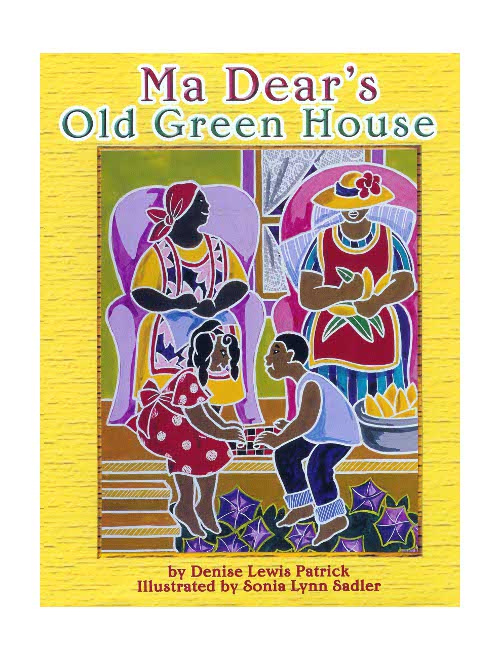

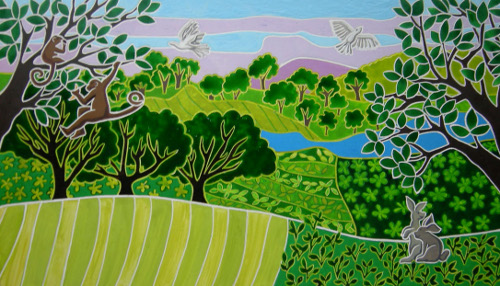
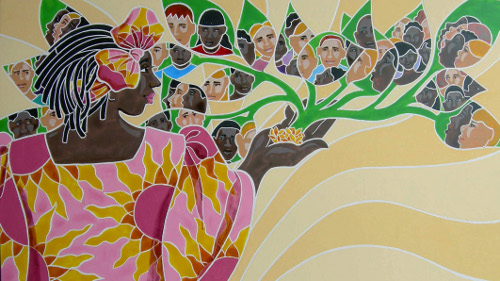
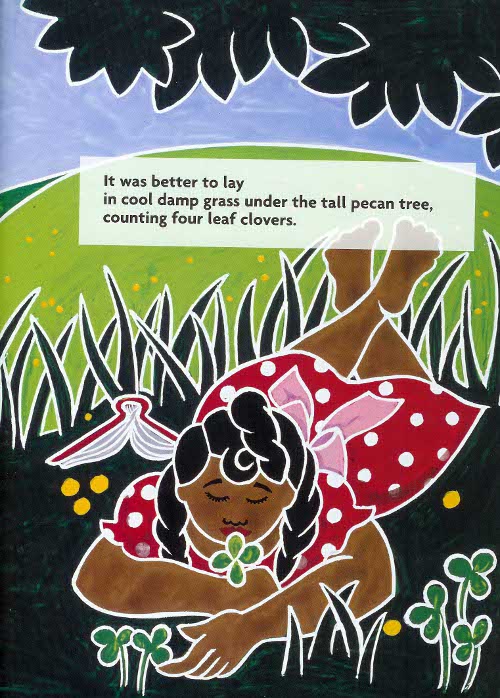

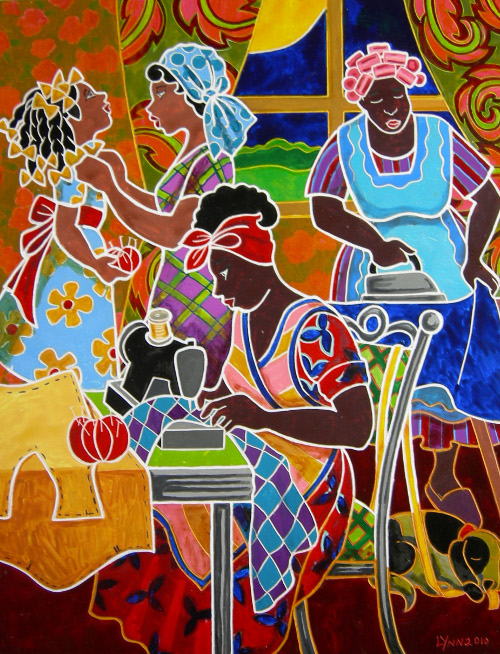
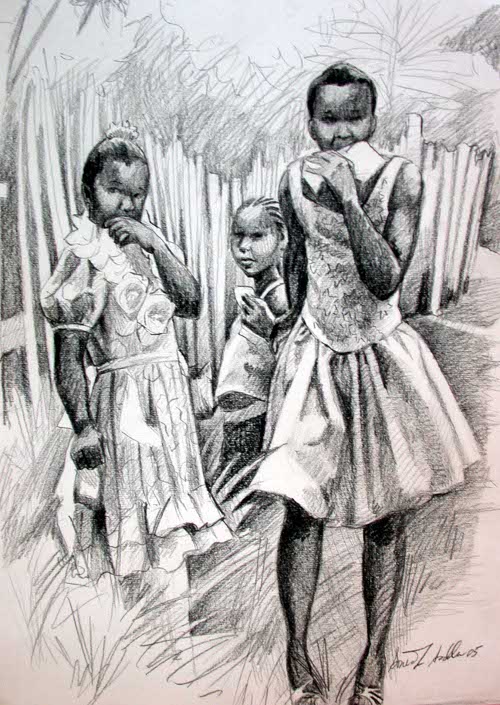
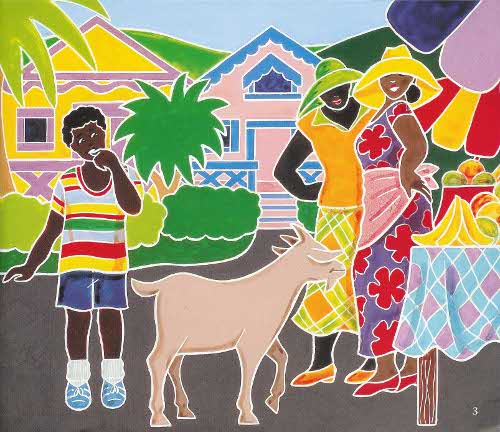
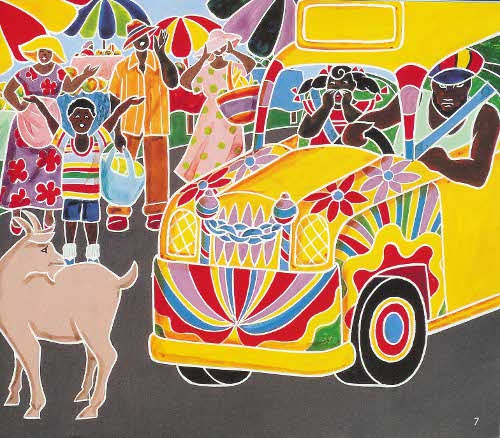

Okay, HOW MUCH do I LOVE those fat pink curlers in the Sew Down illustration??? Love, love, love them; they remind me of being bumped by the wide, soft hips of aunts and great aunts, of kitchens and childhood visits to the South.
And the colors!!
And the skill! I’ve tried scratchboarding, and it’s a lot of fun, but I have zero idea how she does the colors – I’d love to watch her work.
Thank you for an inspiring, wistful-making sort of interview.
Sonia’s images are good for my soul this morning–beautiful and bold and bright. They make you pay attention. I love Seeds of Change, but I hadn’t seen her other books. I’ll be looking them up.
Also, Holly Hobbie is a cool choice of an author/illustrator to meet. I’ve always thought those Toot and Puddle books do not get enough credit for being awesome.
Lovely! I especially liked the crowd scenes — Sewdown (Yes, those pink curlers, which I remember) and Juneteenth at Oak Bluffs.
Sew Down is my favorite, too, you all!
Would you tell us more about your own technique of scratchboard illustration? You appear to handle them like the foundation work for mosaics — very lovely! How do you handle the coloration? I’m guessing Photoshop.
Joy, I’ve asked Sonia if she can answer here. Great question.
Greetings to all,
Thank you for the wonderful and inspiring comments.
To answer questions about technique and color, Scratchboard is a very smooth surface and the paint sits on top on the surface instead of being absorbed. Sometimes the colors are transparent, so that it gives a stained glass look separated by the white carved outline. I do not use photo shop in my work yet. I still do my drawing and painting by hand. Even though the possibilities of photo shop are intriguing, I believe there is a kind of rich energy and flow that exists in things that are done by hand; at some point in the future I may use Photoshop to play with cut and paste, layout and color. The foundation and finial artwork will usually be done by hand.
I think it is great for kids to see what actual fine art painting and drawing looks like presented in children’s books.
The way I use color is a natural attribute, I play one color against another to make them stand out. My head just works that way. The white outline further enhances the bright colors, I have left grayed subtle color for a while but I will revisit them at some point.
Best Wishes
Sonia Lynn Sadler
Thank you, Sonia, for your detailed and thoughtful response. I know my students will especially appreciate your comments about the vicarious thrill of working in the color in by hand.
“I think it is great for kids to see what actual fine art painting and drawing looks like presented in children’s books.”
Amen. One of the best things about picture books, in my opinion.
[…] Sonia Lynn Sadler, pictured left, on April 7, 2011: “Three Little Girls [pictured above] is an example of my pencil drawings that I do mainly […]